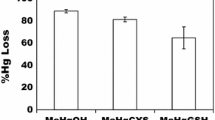Abstract.
Using a newly identified organomercury lyase gene (merB3) expression system from TnMERI1, the mercury resistance transposon first found in Gram-positive bacteria, a dual-purpose system to detect and remove organomercurial contamination was developed. A plasmid was constructed by fusing the promoterless luxAB genes as bioluminescence reporter genes downstream of the merB3 gene and its operator/promoter region. Another plasmid, encoding mer operon genes from merR1 to merA, was also constructed to generate an expression regulatory protein, MerR1, and a mercury reductase enzyme, MerA. These two plasmids were transformed into Escherichia coli cells to produce a biological system that can detect and remove environmental organomercury contamination. Organomercurial compounds, such as neurotoxic methylmercury at nanomolar levels, were detected using the biomonitoring system within a few minutes and were removed during the next few hours.
Similar content being viewed by others
Author information
Authors and Affiliations
Additional information
Electronic Publication
Rights and permissions
About this article
Cite this article
Narita, .M., Yamagata, .T., Ishii, .H. et al. Simultaneous detection and removal of organomercurial compounds by using the genetic expression system of an organomercury lyase from the transposon TnMERI1 . Appl Microbiol Biotechnol 59, 86–90 (2002). https://doi.org/10.1007/s00253-002-0946-3
Received:
Revised:
Accepted:
Issue Date:
DOI: https://doi.org/10.1007/s00253-002-0946-3




